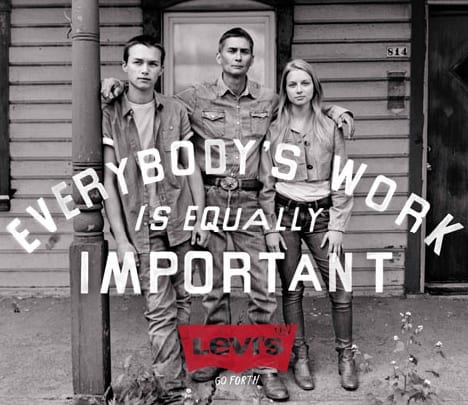By Pamela Rutledge and Bonnie Buckner
The Levi’s Go Forth/We Are All Workers Campaign has focused a lot of attention on the town of Braddock, PA. Levi’s uses Braddock to frame a struggling former steel town with a Depression-era narrative. Levi’s linked the culturally iconic metaphor of the Depression with their jeans through story. While branding through storytelling is a powerful communication device, we find the Levi’s campaign questionable and alarming on multiple levels.
Drawing parallels between the recession of today and the Great Depression is not only inaccurate but dangerous. It contributes to a public sentiment of fear and anxiety. There are many people struggling right now, but as those who lived through 1930s will tell you, we’re not there. At the depths of the Great Depression from 1929-1930, US unemployment was 25%, crop prices fell by nearly 60%, industrial production was down 46%, foreign trade dropped 70%, and the stock market lost nearly 90% of it’s value. At the beginning of 1939, the Dow Jones Industrial Average was 133. Today, the Dow is over 12,000, US unemployment is around 9%, and we have rising foreign trade and commodities prices. In other words, the Depression was really, really, really bad compared to where we are today.
In their campaign, Levi’s has romanticized the Depression era through their beautiful, moody black and white photography, and trivialized the experience of those who suffered through it in the process. By invoking the “Grapes of Wrath” metaphor, Levi’s has implied that we are,as a country, facing similar hardships by linking those images with narratives and slogans like “We are all workers” and “Go Forth to Work”.
The American people have incredible resilience, and have, by necessity rebuilt, renewed, and reinvented themselves, their communities, and the country. This is an attribute to be respected, heralded, and fostered. We are firmly in favor of companies who use their advertising dollars to promote optimism and pride and to increase awareness of others’ problems. Those are campaigns that support necessary profit motives with social concern. However, Levi’s fell prey to marketing hubris in creating the stylized, slick videos in the Go Forth campaign which are so ‘artsy’ that they become a mockery rather than a celebration of human strength. In fact, many have reacted to this campaign by creating and posting parodies of the Go Forth videos on YouTube. We know emotions are contagious. There is no excuse for spreading depression.

Life is tough in Braddock, Pennsylvania and has been since the steel mills closed. Instead of touching emotion, the Levi’s campaign feels like manipulation and exploitation of the very people it pretends to promote.
Levi’s shows us scenes mimicking the Great Depression with real people from Braddock wearing Levis, dressed up to look cool, gritty, and stylish in that dusty, Steinbeck, sweaty, shirtless kind of way, with quotes from great American authors providing a poetic dressing about helping people. Levi’s then adds insult to injury by running a parallel campaign with the same stylishly gritty visual format presenting a very sexualized juxtaposition of images with cultural metaphors of the Depression era. This brings to mind an equally off-putting, visually similar (and brand-detracting) 2006 M. Gondry video using the same smirky cognitive dissonances centered around a Depression-era young man picking up his date with references to the Levi’s condom pocket.
In spite of the multiple points of entry to the campaign and a confusing number of slogans, they all occupy the same visual and metaphorical space under the brand umbrella of Levi’s and, as such, become the same message, for better or worse. The net result is a meaning that is insulting to not just Braddock but all of us: “Poor is the new sexy, it’s even erotic.” Guess what – it’s not.
Many have called attention to what is perceived as the hypocrisy of Levi’s, who, since 2002, operates almost entirely overseas. Is it their job to move back over here? No. But it is pretty tacky to use a town’s lost manufacturing base as its campaign to sell jeans. It also does an injustice to the town of Braddock and the efforts they have made to proactively pursue revitalization by attracting new residents due to the availability inexpensive homes for restoration, encouraging artists to come with promises of studio and gallery space, and other creative efforts to populate the town and bring in new ideas. (See the NY Times Magazine article Mayor of Rust.
The Levi’s campaign isn’t respectful of the people of Braddock. It makes light of their situation by, first, stereotyping their individual humanity through the use of the powerful Depression-era metaphors. Second, it exploits their dignity by fitting Braddock into the Levi narrative, rather than using the Levi narrative to bring awareness to their challenges and propose a solution (beyond being grittily sexy).
In Part 2, we’ll talk about the missed branding and social opportunities and the Karma Capital that got away.

 Dr. Pamela Rutledge is available to reporters for comments on the psychological and social impact of media and technology on individuals, society, organizations and brands.
Dr. Pamela Rutledge is available to reporters for comments on the psychological and social impact of media and technology on individuals, society, organizations and brands.
[…] http://athinklab.com/2011/02/16/levis-go-forth-and-exploit-part-1/ jQuery(document).load(function(){ stLight.options({publisher:''}); });emailprintDigg Diggvar dd_offset_from_content = 40; var dd_top_offset_from_content = 0; /* Tags: brand, Levi Strauss Retweet ThisShare ThisStumbleUpon ThisDigg ThisBookmark This […]